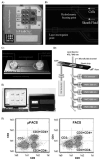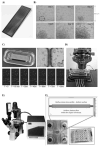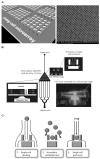Rise of the micromachines: microfluidics and the future of cytometry
- PMID: 21704837
- PMCID: PMC3241275
- DOI: 10.1016/B978-0-12-374912-3.00005-5
Rise of the micromachines: microfluidics and the future of cytometry
Abstract
The past decade has brought many innovations to the field of flow and image-based cytometry. These advancements can be seen in the current miniaturization trends and simplification of analytical components found in the conventional flow cytometers. On the other hand, the maturation of multispectral imaging cytometry in flow imaging and the slide-based laser scanning cytometers offers great hopes for improved data quality and throughput while proving new vistas for the multiparameter, real-time analysis of cells and tissues. Importantly, however, cytometry remains a viable and very dynamic field of modern engineering. Technological milestones and innovations made over the last couple of years are bringing the next generation of cytometers out of centralized core facilities while making it much more affordable and user friendly. In this context, the development of microfluidic, lab-on-a-chip (LOC) technologies is one of the most innovative and cost-effective approaches toward the advancement of cytometry. LOC devices promise new functionalities that can overcome current limitations while at the same time promise greatly reduced costs, increased sensitivity, and ultra high throughputs. We can expect that the current pace in the development of novel microfabricated cytometric systems will open up groundbreaking vistas for the field of cytometry, lead to the renaissance of cytometric techniques and most importantly greatly support the wider availability of these enabling bioanalytical technologies.
Copyright © 2011 Elsevier Inc. All rights reserved.
Conflict of interest statement
The authors declare no conflicting financial interest.
Figures





Similar articles
-
Cytometry in cell necrobiology revisited. Recent advances and new vistas.Cytometry A. 2010 Jul;77(7):591-606. doi: 10.1002/cyto.a.20889. Cytometry A. 2010. PMID: 20235235 Free PMC article. Review.
-
Micro- and nanotechnology in cell separation.Int J Nanomedicine. 2006;1(1):3-14. doi: 10.2147/nano.2006.1.1.3. Int J Nanomedicine. 2006. PMID: 17722258 Free PMC article. Review.
-
The intersection of flow cytometry with microfluidics and microfabrication.Lab Chip. 2014 Mar 21;14(6):1044-59. doi: 10.1039/c3lc51152a. Lab Chip. 2014. PMID: 24488050 Free PMC article. Review.
-
Current Trends of Microfluidic Single-Cell Technologies.Int J Mol Sci. 2018 Oct 12;19(10):3143. doi: 10.3390/ijms19103143. Int J Mol Sci. 2018. PMID: 30322072 Free PMC article. Review.
-
Recent advances in electric analysis of cells in microfluidic systems.Anal Bioanal Chem. 2008 Jun;391(3):933-42. doi: 10.1007/s00216-008-1899-x. Epub 2008 Mar 12. Anal Bioanal Chem. 2008. PMID: 18335214 Review.
Cited by
-
From single cells to deep phenotypes in cancer.Nat Biotechnol. 2012 Jul 10;30(7):639-47. doi: 10.1038/nbt.2283. Nat Biotechnol. 2012. PMID: 22781693 Review.
-
A contact-imaging based microfluidic cytometer with machine-learning for single-frame super-resolution processing.PLoS One. 2014 Aug 11;9(8):e104539. doi: 10.1371/journal.pone.0104539. eCollection 2014. PLoS One. 2014. PMID: 25111497 Free PMC article.
-
Chromosomes in the flow to simplify genome analysis.Funct Integr Genomics. 2012 Aug;12(3):397-416. doi: 10.1007/s10142-012-0293-0. Epub 2012 Aug 16. Funct Integr Genomics. 2012. PMID: 22895700 Free PMC article. Review.
-
Tumour Heterogeneity: The Key Advantages of Single-Cell Analysis.Int J Mol Sci. 2016 Dec 20;17(12):2142. doi: 10.3390/ijms17122142. Int J Mol Sci. 2016. PMID: 27999407 Free PMC article. Review.
-
Microfluidic flow cytometry: The role of microfabrication methodologies, performance and functional specification.Technology (Singap World Sci). 2018 Mar;6(1):1-23. doi: 10.1142/S2339547818300019. Epub 2018 Mar 16. Technology (Singap World Sci). 2018. PMID: 29682599 Free PMC article.
References
-
- Andersson H, van den Berg A. Microtechnologies and nanotechnologies for single-cell analysis. Curr Opin Biotechnol. 2004;15:44–49. - PubMed
-
- Arndt-Jovin DJ, Jovin TM. Computer-controlled multiparameter analysis and sorting of cells and particles. J Histochem Cytochem. 1974;22:622–625. - PubMed
-
- Baret JC, Miller OJ, Taly V, Ryckelynck M, El-Harrak A, Frenz L, Rick C, Samuels ML, Hutchison JB, Agresti JJ, Link DR, Weitz DA, Griffiths AD. Fluorescence-activated droplet sorting (FADS): efficient microfluidic cell sorting based on enzymatic activity. Lab Chip. 2009;9:1850–1858. - PubMed
Publication types
MeSH terms
Grants and funding
LinkOut - more resources
Full Text Sources
Other Literature Sources
Miscellaneous

